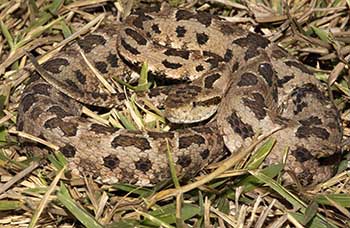
Nic Bishop
Author and Photographer
of Nature Books for Children
Some encounters with Snakes
The thing about snakes it that you never know when you might bump into one. They invest so much effort in avoiding us that encounters are rare. Perhaps thankfully so. But one thing is certain. Each meeting is an event you will never forget.
Once, while photographing in Costa Rica, I stepped back in some long grass to better frame a shot and immediately trod on something distinctively firm yet rubbery. It felt like standing on a child's arm, a dead giveaway for what I knew was going to be an awkward introduction. For a second or two I wondered which of us would make the first move, and then I stepped off as nonchalantly as I could, hoping that the object under my foot might not have noticed that I'd trodden on it, or at very least that it might treat me leniently. Next I watched with uncertain awe as a five foot snake uncurled from the grass. My friend standing nearby, who seemed to know about snakes, helpfully volunteered that it was a fer-de-lance, which is definitely not what you want to stand on. The fer-de-lance has potent flesh-eating venom. You suffer a decay of your body along with profuse bleeding, described by the biologist, Clodomiro Picado, as having to witness one's "body becoming a corpse, piece by piece".
Standing in the long grass, our view of the snake wasn't perfect, and because it hadn't bitten me, I was inclined to think it might have been a relatively harmless boa. But who knows? Neither of us were game for a closer look.
Such encounters are not uncommon in the tropics. I remember being hit in the back of the head one dark night in the Amazon by a snake living in the rafters of a latrine. It's something that can spoil your whole evening, wondering what type of snake it was. Another time, while working with Sy Montgomery in French Guiana, we watched a snake exit her shoe just as she was about to put it on. It was beautiful and moved with a slow unsettling confidence. Then there was the time I was walking at night in the Brazilian Pantanal. I didn't have a flashlight and was carefully following in the footsteps of the person in front when I was surprised to see a dark circle writhing inches from my foot. This time I could identify it as a fer-de-lance, because I stopped to take a photograph. It was standing its ground, vibrating its tail with indignation at having been almost trodden on twice, and poised to bite the third person following me.

My most memorable snake encounter was in Queensland, Australia. In my twenties I spent almost a year traveling from farm to farm in the Outback, working as an itinerant laborer. Of all the jobs I did, the most physically punishing was picking water melons. You spend hours at a time plucking them (a decent water melon weighs over 50 pounds) from the ground and throwing them to a daisy chain of people loading them on a truck.
The interesting thing about water melons is that they warm up in the afternoon sun and hold their heat into the night, which makes them attractive objects for warmth-loving snakes to sleep under. And there each snake rests, until next morning when you pluck the roof from its bedroom. We never knew what snake we would find under a melon, and in a perverse way, the guessing became a lottery to alleviate the back-breaking tedium. Until you found a taipan.
Nothing focuses the mind like coming across a taipan. It is considered the world's deadliest terrestrial snake, with venom potent enough to kill up to 60 people and the habit of striking repeatedly. But fortunately for us pickers, water melons are also good at holding the cool of the night into the day. So as long as we picked the melon early, before the sun was high, the sleeping snake would always be too cold to make a fast move. And as a rule, we never picked water melons after midday.
The only time I was bitten hard was by a brown tree snake. These snakes have caused mayhem by hitching rides on ships and aircraft to snake-free islands in the Pacific. The island bird populations, being naive of snakes, have largely been wiped out by brown tree snakes, which are very aggressive hunters.
A friend of mine studies brown tree snakes with the hope of finding ways to control them, and I asked if I could photograph one of his animals. We placed it on a branch, held by an assistant. Everything was going well until I waved my hand, very slightly, to get the assistant to move the branch. This was all it took to insult the brown tree snake, which launched itself through the air to engulf my hand in its jaws. I never had time to see it coming, and it hit with such force that I was pulling glassy shards of its broken teeth from my hand for weeks afterwards.
Luckily for me, brown tree snakes are not very venomous (although a bite can certainly be more serious for young children), and if you are wondering about the poor snake losing some teeth, these are replaced regularly as part of doing business. What shocked me was the speed of the snake bite. First aid manuals instruct you to stay calm and avoid raising your heart rate. But the reality is that adrenaline surges into your bloodstream. My heart beat so fast I almost passed out.

Text and Images - Copyright Nic Bishop